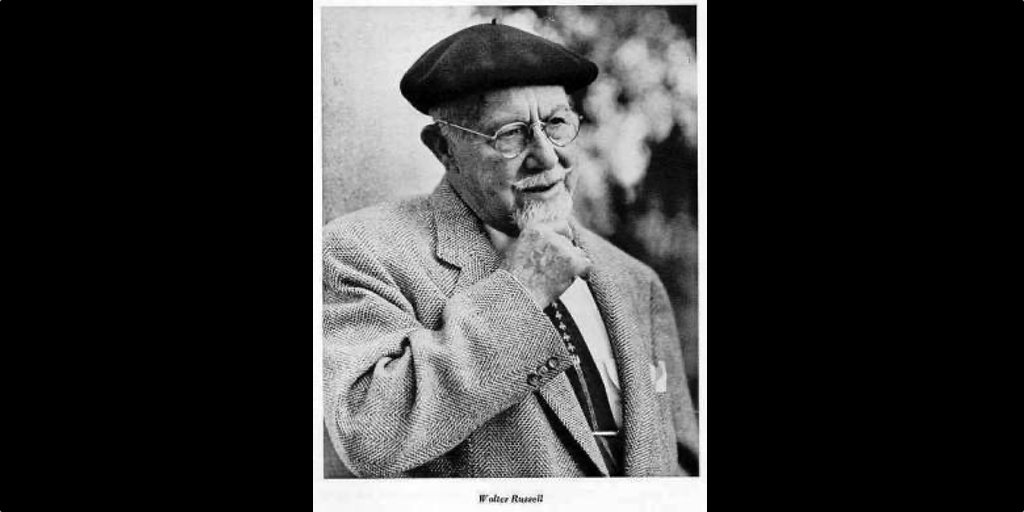Walter Russell (1871-1963) was an American polymath who made significant contributions in the fields of science, art, philosophy, and spirituality. He was a self-taught artist, sculptor, musician, author, and inventor, as well as a scientist and philosopher. Russell’s life was marked by a series of remarkable accomplishments and achievements, but he was also a controversial figure whose ideas were often dismissed or overlooked by mainstream scholars and scientists during his lifetime.
Biography
Walter Russell was born in Boston, Massachusetts, in 1871. He grew up in poverty and received only a limited formal education, dropping out of school at the age of 9. Despite his lack of formal education, Russell was a prodigious learner and became interested in many different subjects, including art, music, science, and philosophy.
As a young man, Russell worked as a photographer’s assistant and later as a stage designer for various theatrical productions. He also developed an interest in sculpture and became a self-taught artist, creating works that were exhibited in galleries and museums across the United States.
In the early 20th century, Russell turned his attention to science and began to develop new theories in physics, chemistry, and biology. He believed that the universe was a giant hologram that could be explained through a single principle of rhythmic balanced interchange between opposing forces. He also developed a theory of atomic structure and the nature of light that challenged many of the established ideas of his time.
In the 1920s, Russell wrote several books outlining his scientific theories, including “The Universal One” and “The Secret of Light.” These books integrated his artistic and scientific theories and presented a new cosmogony that challenged many of the established beliefs in science and philosophy.
In addition to his work in science and art, Russell also became interested in philosophy and spirituality. He believed that all of creation was governed by a universal consciousness that could be experienced through meditation and contemplation. He taught that the purpose of human life was to achieve a state of harmony and balance with this universal consciousness, and that this could be achieved through the cultivation of inner awareness.
Russell died in 1963 at the age of 91. Despite his many accomplishments, he was largely overlooked by mainstream scholars and scientists during his lifetime, and his work has only recently begun to receive renewed attention and interest.
Teachings
Walter Russell’s teachings covered a broad range of subjects, including science, art, philosophy, and spirituality. Some of the key ideas and concepts that he developed include:
- The Russell Cosmogony: Russell believed that the universe was a giant hologram that could be explained through a single principle of rhythmic balanced interchange between opposing forces. He believed that this principle governed all aspects of creation, from the smallest subatomic particles to the largest galaxies.
- Atomic Structure: Russell developed a theory of atomic structure that challenged many of the established ideas in physics. He believed that atoms were not made up of protons, neutrons, and electrons, but were instead composed of spiraling vortices of energy.
- Light: Russell believed that light was not a particle or a wave, but was instead a dynamic force that moved in a spiral motion. He believed that this spiral motion was responsible for creating all of the forms and structures in the universe.
- Inner Awareness: Russell believed that the purpose of human life was to achieve a state of harmony and balance with the universal consciousness that governs all of creation. He taught that this could be achieved through the cultivation of inner awareness, meditation, and contemplation.
Proponents and Critics
Walter Russell’s ideas and theories have been both supported and criticized by scholars and
scientists over the years. Some of his proponents argue that his theories have the potential to revolutionize our understanding of the universe and could have practical applications in areas such as energy production and medical research.
On the other hand, many critics argue that Russell’s theories are unscientific and lack empirical evidence to support them. Some scientists have dismissed his ideas as pseudoscience, and his work has often been marginalized or ignored by mainstream scientific communities.
Despite the criticisms, there is a growing interest in Russell’s work today, particularly in alternative and spiritual communities. Many people are drawn to his holistic approach to understanding the universe and the interconnectedness of all things. His teachings on inner awareness and meditation are also gaining popularity, as people seek to find ways to connect with the spiritual aspect of their lives.
Legacy
Walter Russell’s legacy is a complex one, as his work has been both celebrated and criticized over the years. While his ideas have yet to be fully accepted by mainstream science, his legacy continues to inspire and influence people in various fields.
Russell’s teachings on the interconnectedness of all things and the importance of inner awareness have influenced many spiritual and philosophical movements. His work on the nature of light and atomic structure has also inspired some scientists to explore new avenues of research.
Today, Walter Russell’s work is perhaps best viewed as an invitation to explore new ways of thinking about the universe and our place within it. While his ideas may challenge some of our most deeply held beliefs, they also offer the possibility of a new and more expansive understanding of reality. Whether or not his theories are ultimately proven to be true, his legacy as a visionary thinker and polymathic genius continues to inspire and challenge us to think differently about the world we inhabit.
Join the conversation
WordPress comments are disabled, but you can freely discuss this topic on the Fire Faith Fellowship fediverse server.

